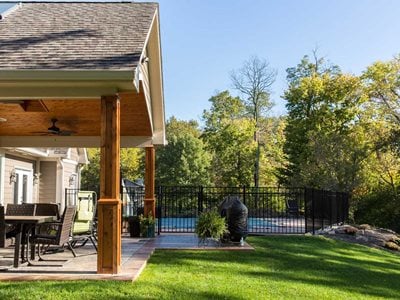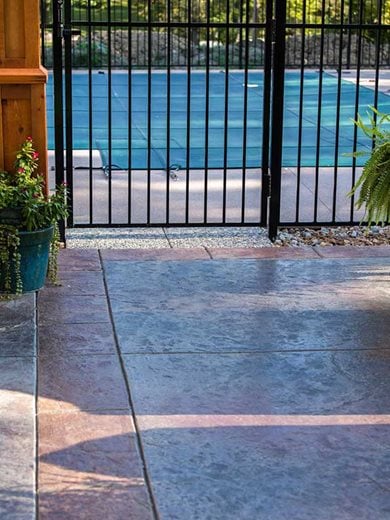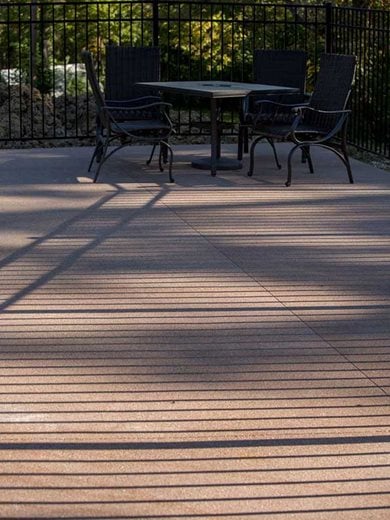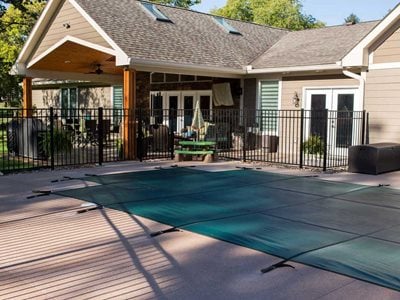
Everyone struggles with concrete patios ideas. There are so many options for finishing concrete that the average person can have a hard time deciding. There are literally thousands of options when you look at all the colors and finishes available. The sky is the limit.
Stamp concrete patterns make up the most classic options for concrete patios ideas. This is how you can recreate all sorts of traditional materials like brick, stone, and slate. In fact, if you've ever admired a good looking slate patio, there's a good chance it was actually concrete! That said, the best stamped concrete patios require skill, high quality tools, and a good attention to detail. Absent these qualities, stamped concrete may end up looking "fake" or unrealistic.
Stamped concrete excels at durability and maintenance. Compared to other traditional materials, textured concrete has comparatively low maintenance requirements. With only periodic cleaning and resealing, stamped concrete should maintain its appearance for decades. Natural pavers or decorative concrete block pavers, on the other hand, will settle and become uneven. They will also allow weeds to grow between each paver.
Of all the concrete patio ideas, stamped concrete is the highest detail option. As such, it tends to be more expensive than other decorative concrete finishes. This is especially true with more artistic applications. If the installer uses more than one stamp pattern, includes decorative borders, or adds highlighting stain, this all improves the appearance for an added cost. Despite this, however, textured concrete patios are still generally less expensive than comparable stone, slate, or concrete paver options.
Exposed aggregate is the classic concrete finish that's experiencing a big comeback. As the name implies, exposed aggregate is just concrete that has had enough cement removed to expose the aggregate. This can take the form of sands and rocks of various size. To mimic or supplement this effect, aggregates can also be seeded into the surface of the concrete at different stages. Some people will also call this a concrete acid wash finish.


Exposed aggregate has a few key selling points. First and foremost, it is very economical among concrete patios ideas. It requires few extra tools or materials and, depending on the design, little extra labor versus smooth concrete. Exposed aggregate is also very durable. In concrete, aggregate is the hardest part. By prematurely exposing the aggregate, this creates a harder surface that is less prone to showing wear over time.

Exposed aggregate does not compare to many other materials. It has a distinct appearance. That makes it very attractive to people who worry about something that looks artificial. As something so fundamentally simple, exposed aggregate also allows for a lot of variation and customization. Finishes can range from the lightest sand finishes that only expose a fraction of a millimeter to super heavy exposure that show large stones. To jazz up an exposed aggregate finish, use decorative saw cuts, stains, or stencils. Concrete Dimensions stencils, specifically, are designed to work with exposed aggregate finishes to create crisp, unique imprinted patterns.
Smooth finished concrete is essentially the default. This does not mean, however, that is has to be boring. Simple steps can be taken to improve the appearance of smooth finish concrete. For example, just adding color to the concrete can dramatically change the appearance and make the concrete into a valuable design element. Depending on the desired color, available materials, and desired amount of labor required, integral colors and color hardeners are both suitable choices. In general, integral color requires less labor but is more limited in color selection. Color hardeners, on the other hand, will produce a wider range of more vibrant colors but require a great deal more labor.
There are still options for existing smooth finish concrete, as well. Surface-applied recoloring products, such as Cem-Coat and Refresh add color to the surface of cured concrete. Water-based stains and acid stains are also good options for adding color after the fact. Many of these coloring products can also be used to create artistic design and patterns. This can create borders, crest and logos, or just multi-colored spaces.
Explore impressive concrete installations to find inspiration for your next project.
Find out how much color and fiber you'll need for any size project.